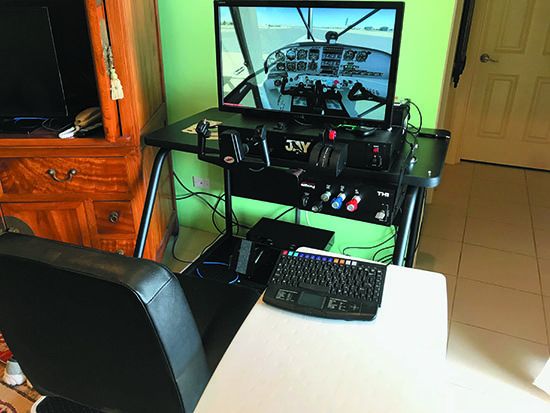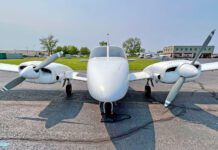ALWAYS JUST A SIMULATOR
I thought I would weigh in on my home flight simulator experience. I purchased a Redbird Jay some eight months ago, including chair, stand, rudder pedals and optional three-control pedestal. I bought this rather than the certificated Cessna 172 sim as I no longer need to log time, and the Jay gave me a larger number of aircraft options—including the Maule M7 on wheels and skis, which I had flown for many years.
I am on the island of Saipan, so all of the setup and support has to be done remotely. Redbird, however, has done a very good job with this. I purchased this as it is not realistic to own an aircraft where I live, and there are none available for rent or instruction. I wanted to retain some flying skills.
The Jay does not allow the three- screen option, and the monitor sits somewhat high for a slightly unrealistic feel. I agree with your previous field reports that the graphics are not wonderful. I think they are at “pretty good,” at best. It is fun to do touch and goes at Pyongyang, North Korea, but I’m pretty sure the terrain, which is the same resolution as Fresno, bears no relation to reality. It does we’ll for IFR training, but the rudders become very oversensitive at slow airspeeds. The Jay does allow practicing emergency landings or off-airport operations if done exactly right, but if the airspeed and flare are not exactly right, you crash. There may be adjustments to improve this, but the time zone difference to the company here discourages a lot of tweaking. The Cessna 172 program is the best and nearly the same as the certificated version, but it certainly is not perfect.
I have been to FlightSafety International several times, and even its non-motion sims are worlds ahead. There is never going to be confusion with the Jay that you are actually flying an airplane. The controls are slightly sticky, despite lubrication, the throttle is not linear in its action, and, of course, there is no tactile feedback.
The instructor station works fine, but of course you have to have another pilot or instructor to manage it. All you can do as a single pilot is the equivalent of touch and goes. Still, for a pilot, like me, who does not have access to a real airplane, it serves as a reasonable reminder of what flying is like. In summary, my Redbird is a good simulator, but it will always be just a simulator.
David Grauman – Saipan, North Mariana Islands
MORE ON THE SKYMASTER
One item I found missing in your Used Aircraft Guide report about flying the Cessna 337 (May 2022 Aviation Consumer) was that when applying power at takeoff, I was taught to first add power to the rear engine, making sure it was making power before throttling up the front engine. That’s simply because you can’t see if the rear engine is running.
Larry Weitzman – via email
I read Aviation Consumer every month and value your contributions when I decide where to spend my limited airplane dollars. I have to take issue with a statement in the article on Skymasters regarding the “hairy-chested thinking of the day” as being the reason for engine cutoff on takeoff. This was an FAA requirement and cost my uncle his life after a long Air Force career, first flying P-51s in the allied invasion of Italy and later F-86s and as an instructor in T-33s. The FAA requirements of that time period for a multi-engine certificate included an engine cut on takeoff. This was not, as suggested by your article, the result of any macho inclination of the instructors. After many unnecessary deaths, the FAA came to understand that the danger of low-altitude engine cuts outweighed the training benefits.
Current training requirements require a 3000-foot AGL minimum for any engine cuts or minimum controllable airspeed training. Engines are not cut except for once at the end of the student’s training just prior to the checkride. During training flights, engines are retarded to minimum thrust so that a restart is not required.
My uncle’s exemplary career did not end because of his behavior, but because of a poorly designed FAA requirement.
Alan H Wells – Atlanta, GA





